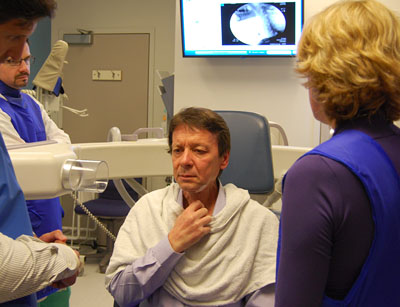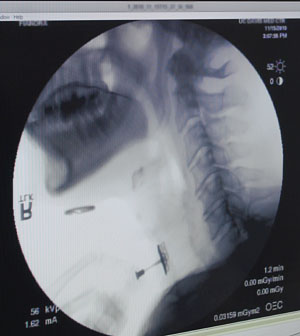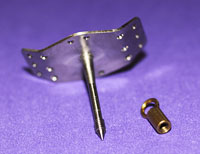
Patient Daniel Fiandra tests his new swallowing device.
Posted Dec. 15, 2010
In what might be one of the world’s first medicinal body piercings, UC Davis Health System surgeons announced today that they have successfully implanted an experimental device in the throat of a man that will enable him to manually control his ability to swallow. The device, which could offer an effective treatment option for people suffering from severe swallowing problems, is controlled by pulling on a tiny metal pin that extends through the skin in the neck. The post, when pulled forward, manually opens the esophagus and allows food and water to pass.
The patient, a Uruguayan physician and a cancer survivor who sought help from UC Davis swallowing experts, came to Sacramento in mid-November for a series of tests and evaluations as follow-up to the implant surgery that took place last summer. Peter Belafsky and Gregory Farwell, both professors of otolaryngology, had traveled to South America in August to perform the unique implantation. With the assistance of Uruguayan medical colleagues, they monitored their patient long distance while waiting for the incision site to fully heal.
After checking the patient’s swallowing control and capabilities using the X-ray technology of a fluoroscope, Belafsky pronounced the experimental device a qualified success and one that could offer a much-needed treatment option for tens of thousands of patients with swallowing disorders known as oropharyngeal dysphagia.

A fluoroscopy X-ray showing the swallowing device in action.
“We’ve developed an earring-like stud that extrudes about a quarter-inch above the skin, much like a body piercing,” said Belafsky, who directs the Voice and Swallowing Center at UC Davis and spent five years developing the device. He designed it to more closely resemble an earring post after taking his two daughters to get their ears pierced.
“By attaching a tiny titanium rod to a postage stamp-sized plate that we’ve sewn into the neck cartilage, we’ve enabled our patient to safely and without pain pull on the device to move his larynx forward and open the esophagus to allow food and liquid to pass,” said Belafsky. “It’s the first time a person has been able to manually control the entryway to the esophagus.”
 “It’s the first time a person has been able to manually control the entryway to the esophagus.”
“It’s the first time a person has been able to manually control the entryway to the esophagus.”
— Peter Belafsky
Severe swallowing disorders are common and costly health problems, according to the National Institute of Neurological Disorders and Stroke and the Journal of Rehabilitation Research and Development. Complications include aspiration, dehydration, pneumonia, malnutrition, depression and death. The problem can be caused by a stroke, head and neck cancer, head injuries, advancing age and diseases such as Alzheimer’s and Parkinson’s. In the United States, an estimated 16.5 million people may need treatment for problems associated with oropharyngeal dysphagia. A variety of surgical procedures are available to improve swallowing function, but such treatments are invasive and may only provide partial relief, and fail in a significant percentage of individuals.
Daniel Fiandra, the Uruguayan doctor who was treated by Belafsky and Farwell, has used a feeding tube for nourishment and has not been able to eat or drink in more than two years after undergoing chemotherapy and radiation treatments for tonsil cancer. Coming from a family of physicians, Fiandra, who is a cardiologist, researched and contacted UC Davis after learning about its expertise in treating voice and swallowing disorders. (A very similar device developed by Belafsky is currently being evaluated by the Food and Drug Administration for a clinical trial at UC Davis.)
At a hospital in Uruguay’s capital of Montevideo, Belafsky and Farwell sutured the t-shaped titanium device into the cricoid cartilage during a 45-minute procedure. They required that he wait several months before attempting to use the device to ensure the incision site fully healed and the device was well-integrated into cartilage located just above the thyroid gland in the throat.

The Swallow Expansion Device developed by UC Davis surgeon and researcher Peter Belafsky.
Using a UC Davis technology transfer grant, which supports medical technology development at the university, Belafsky settled on a design for the tiny device after creating and testing several prototypes. He originally developed a version that used magnets before arriving at the current design for manually controlling the upper esophageal sphincter.
“Most of us don’t even think about the complex physical processes behind eating and swallowing, said Belafsky. “Not being able to swallow is truly a life-altering problem. I’m very optimistic that this tiny biomedical device may help restore quality of life for the many people who suffer from severe swallowing problems.”
Having extensively assessed the device’s efficacy and safety in animal and cadaver models before implanting into his first patient, Belafsky is optimistic that clinical trials will be approved to begin testing in the United States. Fiandra, the Uruguayan patient, returned home to South America earlier this month, where he will continue to practice swallowing for the first time in more than two years.
UC Davis has already patented the device. Along with obtaining FDA approval to conduct clinical trials in the U.S., Belafsky also is working to secure funding to conduct the anticipated trials.
Head and neck surgery at UC Davis
The UC Davis Department of Otolaryngology and Head and Neck Surgery is one of the most well rounded and balanced programs of its kind in the United States. The department has sub-specialists in all of the major disciplines necessary to manage the wide range of problems that beset the head and neck, including infections, trauma, birth defects, tumors and degenerative diseases; problems related to hearing, balance, taste and smell; and functional disorders of the voice and swallowing. Salivary gland disorders, sleep apnea and pathological snoring, dysfunction of the facial nerve, facial pain, disturbances in the growth of the facial skeleton and cosmetic problems of the head and neck all fall within the department's scope.